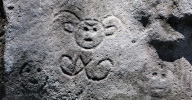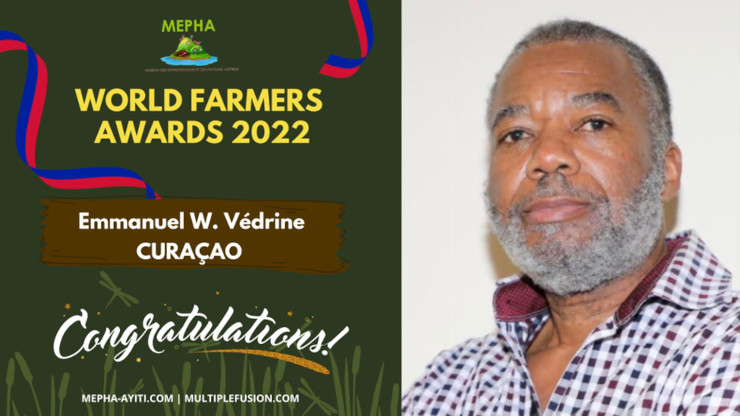| Kaz | Enfo | Ayiti | Litérati | KAPES | Kont | Fowòm | Lyannaj | Pwèm | Plan |
| Accueil | Actualité | Haïti | Bibliographie | CAPES | Contes | Forum | Liens | Poèmes | Sommaire |
Agriculture and irrigation in Haiti
Photo: MEPHA & MULTIPLE FUSION.COM November 18, 2022 : 18 Novanm |
| We thank Dr. Nelson Noël, the president of MEPHA & MULTIPLE FUSION.COM, for this award recognizing and encouraging some people around the world in their works dealing with agricultureandenvironment. | Nou remèsye Dr Nelson Noël, prezidan MEPHA & MULTIPLE FUSION.COM, pou ewad sa a, ki rekonèt e ankouraje kèk moun atravè mond lan nan travay y ap fè ki an rapò ak agrikilti e anviwonnman. |
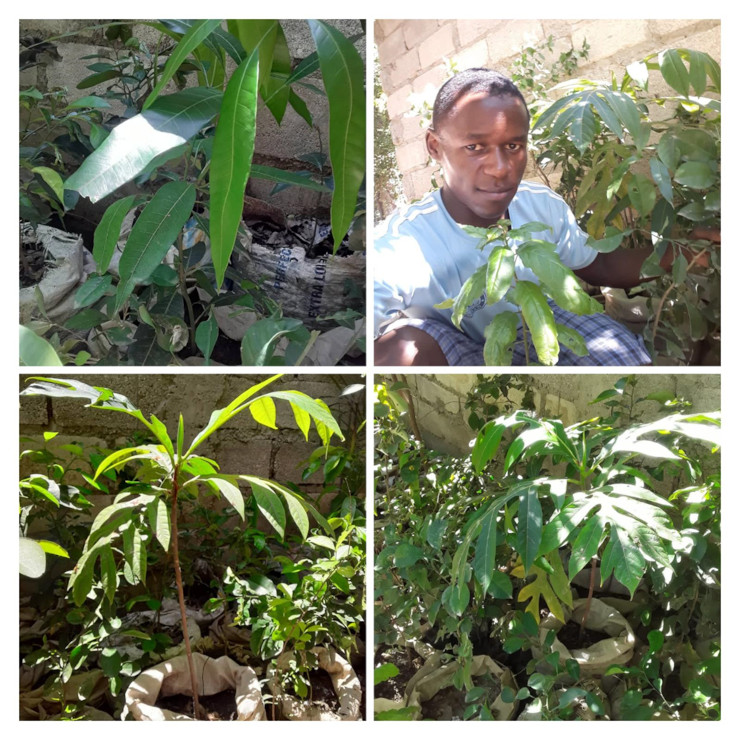
Photo: Fednold Alismé.
picture (A) foto
(•) Pye veritab (lamveritab): breadfruit.
| Some of these irrigation techniques can be used in Haiti to water land so that Haiti can produce a lot of food without spending (a lot) of money because water can be found in many places. | Kèk nan teknik irigasyon sa yo kapab itilize Ayiti pou wouze tè pou Ayiti ka pwodui manje agogo san depanse (anpil) lajan paske moun kapab jwenn dlo plizyè kote. | |
| As writer who was born and grew up in Haiti, I think my native commune (L’Asile /Lazil) was part of paradise when I was a boy. Haiti did not yet look like a desert that time. Three rivers meet less than a minute from our home (on a hill). When opening our windows, we could hear the sound of all the birds in the mountain facing the house, and hunting some of them was one of hobbies. | Kòm ekriven ki fèt e grandi an Ayiti, mwen panse komin (natif) mwen (L’Asile /Lazil) te yon paradi lè m te tigason. Ayiti potko sanble yon dezè alepòk. (Gen) twa rivyè (ki) rankontre mwens ke yon minit de kay nou (ki sou yon kolin). Lè n ouvri fenèt nou, nou te ka tande bri tout zwazo nan mòn ki an fas kay la, epi (fè) lachas yo te youn nan pastan mwen. |
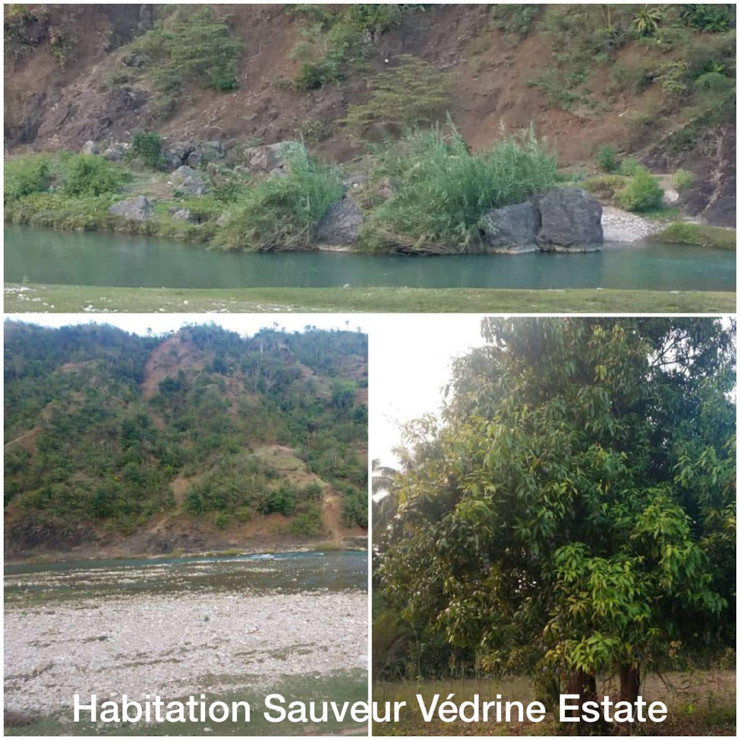
Photo: E. W. Védrine Creole Project. Tournade (Tounad) & Mathias (Matyas), L’Asile (Lazil) Haiti.
picture (B) foto
(•) Example of water that can be found in different places in Haiti, but unfortunately
no irrigation project by any government to help. These waters end up in the sea.
Egzanp dlo moun ka jwenn nan diferan andwa Ayiti, men malerezman pa gen oken
pwojè irigasyon gouvènman genyen pou ede. Dlo sa yo abouti nan lamè.
| We would rarely buy food because we had produced what we needed to eat, and everything was natural. We ate healthily. | Se raman pou n ta achte manje paske n te pwodui sa nou bezwen pou manje, e tout bagay te natirèl. Nou te manje an sante. |
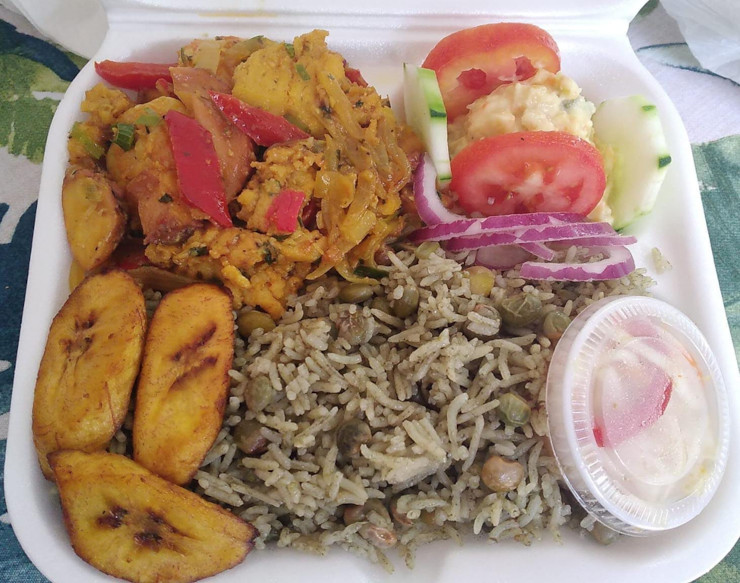
The environment, with all its ingredients was part of our life. Haiti had not been yet deforested at the make to make charcoal everywhere. According to World Bank, charcoal constitutes 92% of burning energy in Haiti. So, clearly, we can have an idea how this beautiful and mountainous country for which Jean-Jacques Dessalines had sacrificed his life to give us freedom has been destroying. Our historical novel, Sezon sechrès Ayiti (Season of drought in Haiti) summarizes all of these problems in a sense. |
Anviwonnman an, ak tout engredyan ladan l, te fè pati de lavi nou. Yo potko debwaze Ayiti nèt alepòk pou fè chabon tout kote. Selon Bank Mondyal, chabon konstitiye 92% (katrevendouz pou san) enèji yo boule an Ayiti. Donk, klèman, nou gen yon ide kòman yo detwi bèl peyi sa a, chaje ak mòn, ke Jean-Jacques Dessalines te sakrifye vi l pou li pou l ban nou libète. Woman istorik nou Sezon sechrès Ayiti, rezime tout pwoblèm sa yo nan yon sans. |
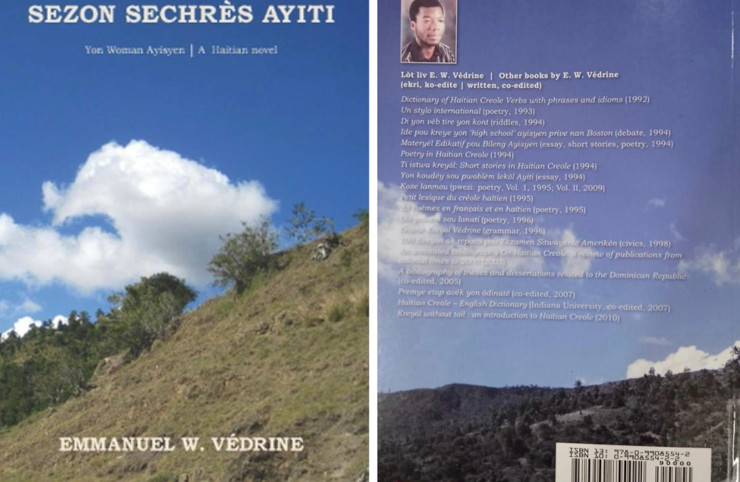
Photo: JEBCA Eds. • Sezon sechrès Ayiti (Haitian novel : Woman ayisyen). 224 p. © by E. W. Védrine. 2014.
picture (D) foto
(•) Sezon sechrès Ayiti (Season of drought in Haiti)
Haitian novel focusing on problems of Haitian peasants
Woman ayisyen ki santre sou pwoblèm peyizan ayisyen
| Despite the negative consequences of this destruction, unfortunately Haitian leaders have no vision for Haiti's development. They have never valued agriculture which is one of the pillars of this country’s development. Hence, that has created rural exodus forcing Haitians (mostly) from the countryside to move to Port-au-Prince (the capital city), trying to make ends meet. | Malgre konsekans negatif destriksyon sa a, malerezman lidè ayisyen pa gen oken vizyon pou devlopman Ayiti. Yo pa janm valorize agrikilti, ki youn nan pilye devlopman peyi sa a. Donk, sa vin kreye egzòd riral ki fòse Ayisyen (patikilyèman) sa yo ki an pwovens vin Pòtoprens (kapital peyi a) pou eseye bat dlo pou fè bè. | |
| Things have turned out to be worse with the fall of the Duvalier’s dynasty (on February 7, 1986) that lasted twenty eight years (from 1957). We are not here to praise them either (father and son) because they did not do any major infrastructural works throughout the country during their tenure in power. They were more interested in holding on to power for life. | Bagay yo vire de mal an pi avèk chit dinasti Duvalier yo (7 fevriye, 1986) ki dire 28 ane (apati 1957). Nou pa la pou lwanje yo nonplis (papa e pitit) paske yo pa t fè oken travay enfrastriktirèl enpòtan atravè peyi a pandan yo sou pouvwa. Yo te plis enterese kenbe pouvwa a avi. | |
| The collapse of the dictatorship has given rise to the following: political vacuum, political instability, high cost of food, insecurity, kidnapping, no agricultural production, professionals have been leaving the country often, Haitians in diaspora fear of going to Haiti for vacation or for their retirement… This is just to name some of the problems that Haiti has been facing since 1986. | Chit diktati a bay nesans a: vakyòm politik, enstabilite politik, lavichè, ensekirite, kidnaping, absans pwodiksyon agrikòl, (sèvo) pwofesyonal k ap kite peyi a de jou an jou, Ayisyen nan dyaspora ki pè antre Ayiti pou pase vakans oubyen pou retrèt yo… Se jis pou site kèk nan pwoblèm Ayiti ap konfwonte depi 1986. | |
| They go to the Dominican Republic, to other parts of the Caribbean (such as the Bahamas, French Guina, the French West Indies…). They go to the United States, Canada, Mexico, and Europe. They went to Chile and Brazil. We have seen how many of those in Chile and Brazil have left (recently) in great numbers, trying to reach Mexico in transit to reach the United States (their final destination). | Y al an Repiblik Dominikèn, lòt kote nan Karayib la (tankou Bahamas, Giyàn Fransèz, Antiy Fransè yo…). Y al Etazini, Kanada, Meksik, e Ewòp. Yo t al Chili ak Brezil. Nou wè anpil nan sa yo ki te Chili ak Brezil kijan yo t ap kite an mas pou eseye rive Meksik, an tranzit pou atenn Etazini (destinasyon final yo). | |
| Despite these compatriots’ tragedies in the twentieth and twenty first centuries, Haitian leaders (in Haiti) still don’t show any remorse or care. They are more interested in ascending to power with a machiavellic philosophy (getting to power by all necessary means). It’s a great tragedy for Haitians in the twentieth and twenty-first century (after 117 years of independence and for a country with the title “The World's First Independent Black Republic”) that should have been a positive model for others. | Malgre trajedi konpatriyòt sa yo nan ventyèm (20èm) e venteyinyèm (21èm) syèk, lidè ayisyen (Ayiti) toujou pa montre oken remò, oubyen kè sansib. Yo ta plis enterese nan monte sou pouvwa avèk yon filolozofi matyavèl (monte sou pouvwa pa tout mwayen posib). Se yon gwo trajedi nan ventyèm e nan venteyinyèm syèk (apre 118 ane endepandans, epi pou yon peyi ki gen tit «Premye Repiblik Nwa nan lemond»), ki ta dwe yon modèl pozitif pou lòt. | |
| Things have gotten even worse after the assassination of President Jovenel Moïse (on July 7, 2021) by local and foreign mercenaries. Though he was blocked by the “local enemies of change”, while in power, he was trying hard to do some small changes (his last year in power) from which the country could have benefited. | Bagay yo vin pi mal toujou aprè «mèsenè lokal kou etranje» asasine prezidan Jovenel Moïse (7 jiyè, 2021) pandan l sou pouvwa. Malgre «ènmi chanjman lokal» yo te bloke l pandan l sou pouvwa, men li t ap eseye fè sa l kapab (dènye ane l sou pouvwa) pou peyi a ta benefisye de sa. |
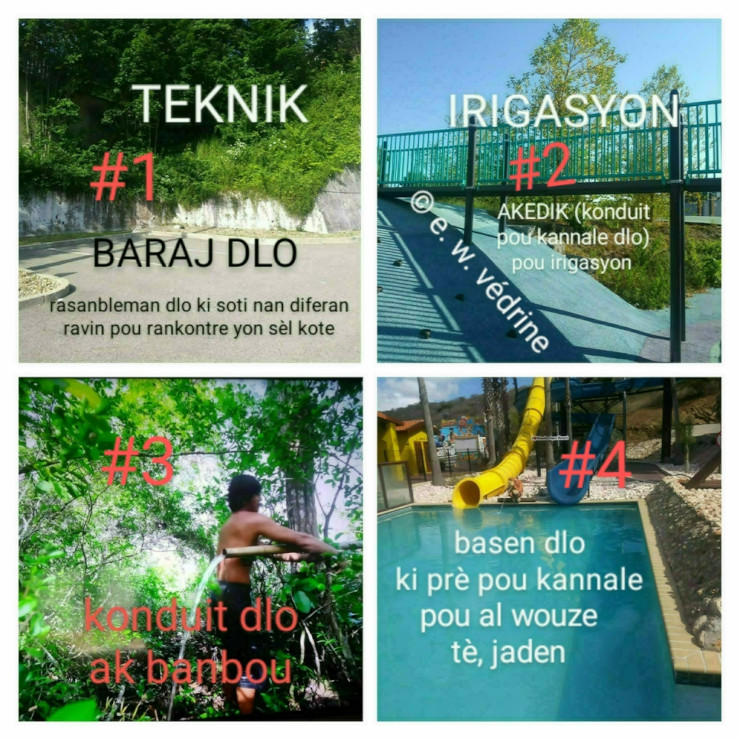
Photo: E. W. Védrine Creole Project.
(#3, Ref. Survival Builder @ SurvivalBuilder)
picture (1) (2) (3) (4) foto
| Irrigation techniques that can be used in Haiti to irrigate land, to produce a lot of food without spending (a lot) of money because there is water in many places that can be channeled... These techniques can be applied to all communes in Haiti to catch water, rainwater, water gathering (from stream, stream, river, well) to fill dams, reservoirs, and wetlands. | Teknik irigasyon ki ka itilize Ayiti pou wouze tè, pou pwodui manje agogo san depanse (anpil) lajan paske gen dlo plizyè kote ki kapab kapte… Teknik sa yo kapab aplike nan tout komin Ayiti pou kapte dlo, dlo lapli, rasanbleman dlo (ravin, sous, rivyè, pui atezyen) pou al plen baraj, rezèvwa e marekaj. |
Look at the pictures : Gade foto yo
#1. The gathering of rainwater from different (paved) streams that are assembled in one place (in a large base or pool) in the form of a trapezoid : Rasanbleman dlo lapli nan diferan ravin (betonnen) ki reyini yon sèl kote (nan yon baz laj oswa basen) an fòm trapèz.
#2. A water conduit via an aqueduct (which can connect 2, 3 valleys channeling water upwards : Yon konduit dlo atravè yon AKEDIK (ki ka konekte 2, 3 vale ki kannale dlo a (pou l pase) anlè.
#3. Several water conduits can be created with bamboo stake or hose to water gardens directly (once the conductor is open for water passage) : Plizyè konduit dlo ka kreye ak (gòl) banbou oubyen kawotchou pou al wouze jaden dirèkteman (yon fwa fant konduit la ouvè pou pasaj dlo).
#4. Several dams or reservoirs can be filled and ready to water garden : Plizyè basen dlo kapab plen, epi prè pou kannale dlo pou al wouze tè, jaden.

Photo: E. W. Vedrine Creole Project.
picture (5) foto
(•) Plastic reservoir : Rezèvwa an plastik
| In picture #5, we are looking at some types of reservoirs to conserve water, rainwater. They can be bought in certain place. Many people who have a tin-roofed house or a concrete roof, it can catch rainwater to conserve it. The rainwater run through the gutters and then fill up many reservoirs. When one is filled, it fills up the other (depending on how many are connected with one another). This same technique can be used in Haiti to conserve rainwater. | Nan foto # 5, n ap gade kèk tip rezèvwa pou konsève dlo, dlo lapli. Yo kapab achte yo kèk kote. Anpil moun ki gen kay (ki kouvri) an tòl oubyen ki an beton kapab kapte dlo lapli pou konsève l. Dlo lapli a pase nan yon goutyè, epi l ka ranpli plizyè rezèvwa. Lè youn fin plen, li ka plen lòt la (depan konbyen ki konekte youn ak lòt). Menm teknik sa a kapab itilize Ayiti pou konsève dlo lapli. |
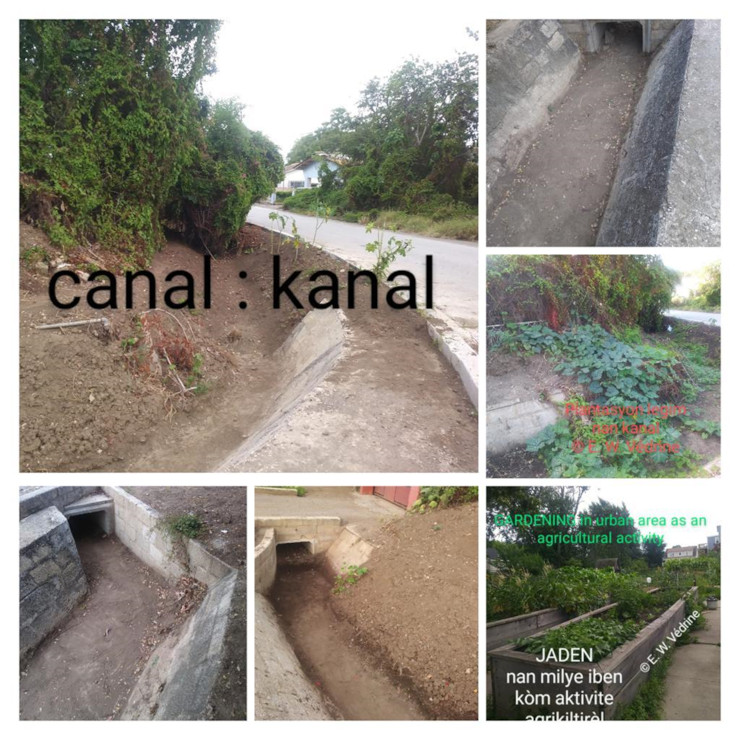
Photo: E. W. Vedrine Creole Project.
picture (6) foto
(•) Water ways should be cleaned before irrigation:
Pasaj dlo (kanal, kanalizasyon) dwe netwaye avan irigasyon
| Once you have gutters, you can organize these reservoirs. They can help watering gardens in your backyard or near your home. You can have a hose conduit or one made of bamboo stake for example to lead the water far away to irrigate gardens. So, when it rains, it will not be wasted but you will be able to save rainwater. You don’t need to wait for rainfall each time to wet your garden. You don't need to complain about the government to come up with water pumps to irrigate your land or garden. | Depi ou gen goutyè, ou ka òganize rezèvwa sa yo. Yo kapab ede w wouze jaden nan lakou w, oubyen touprè kay ou. Ou kapab gen yon konduit kawotchou oubyen (gòl) banbou pa egzanp pou mennen dlo a lwen pou wouze jaden. Donk lè lapli tonbe, li pa pral gaspiye men w ap ka konsève dlo lapli a. Ou pa bezwen rete tann lapli tonbe chak lè pou wouze jaden w. Ou pa bezwen ap plenyen pou leta vin ak ponp dlo pou wouze tè, oubyen jaden ou. |
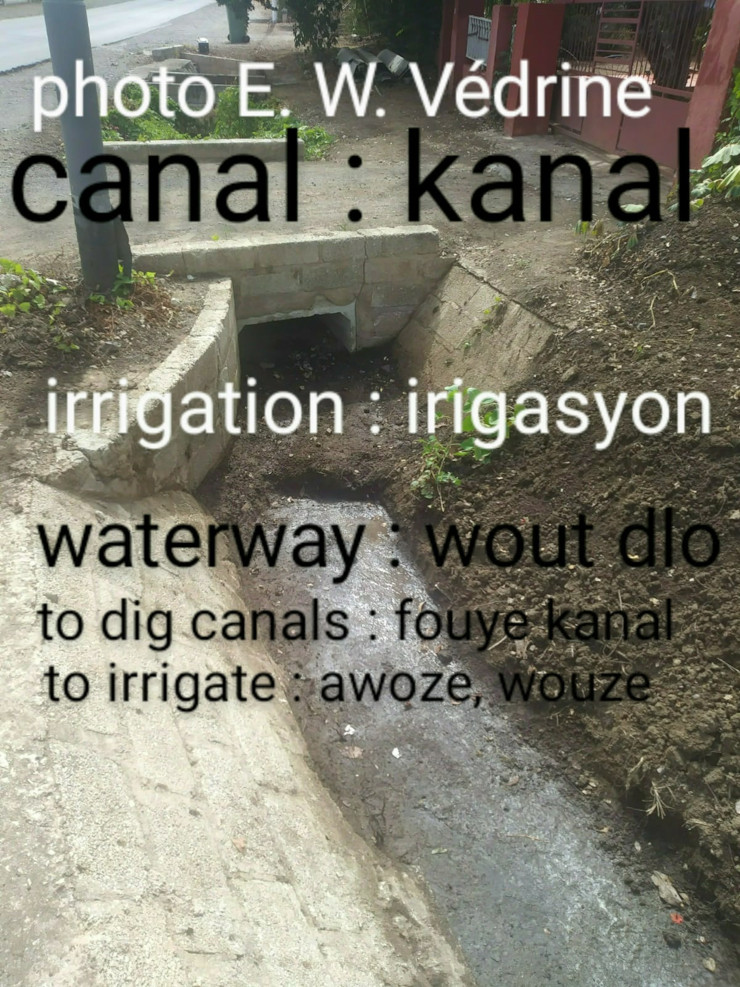
Photo: E. W. Vedrine Creole Project.
picture (7) foto
(•) Water ways : Pasaj dlo (kanal, kanalizasyon)
| You can take these ideas, these tips to make gardens in your backyard or else where you may have land. You can save rainwater to water plants, gardens, trees like mangoes, coconuts, avocadoes… and all other trees bearing fruits and plants for example that you may have in your yard. You can encircle them with blocks and release water in the circle to keep it for a period of times in their roots. You will see your yard quite beautiful instead of complaining all the time. | Ou ka pran ide, konsèy sa yo pou fè jaden nan lakou w, oubyen lòt kote ou ka gen tè. Ou kapab konsève dlo lapli pou wouze plant, jaden, ab fritye tankou mango, kokoye, zaboka… tout lòt ab fritye e plant pa egzanp ke w ka gen nan lakou w. Ou ka ansèkle yo avèk blòk, epi w lage dlo nan sèk la yon fason pou kenbe l pou yon sèten tan nan rasin yo. Ou pral wè lakou w byen bèl, olye pou ap plenyen tout tan. |
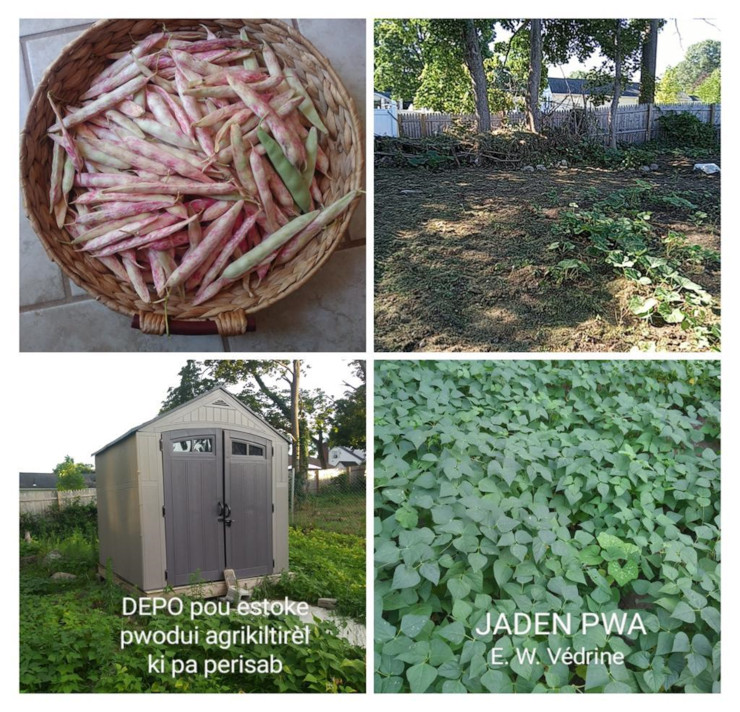
Photo: E. W. Vedrine Creole Project.
picture (8) foto
(•) Storage to store non-perishable agricultural products
Depo pou estoke pwodui agwo-alimantè non-perisab
(•) Jaden pwa : Beans garden
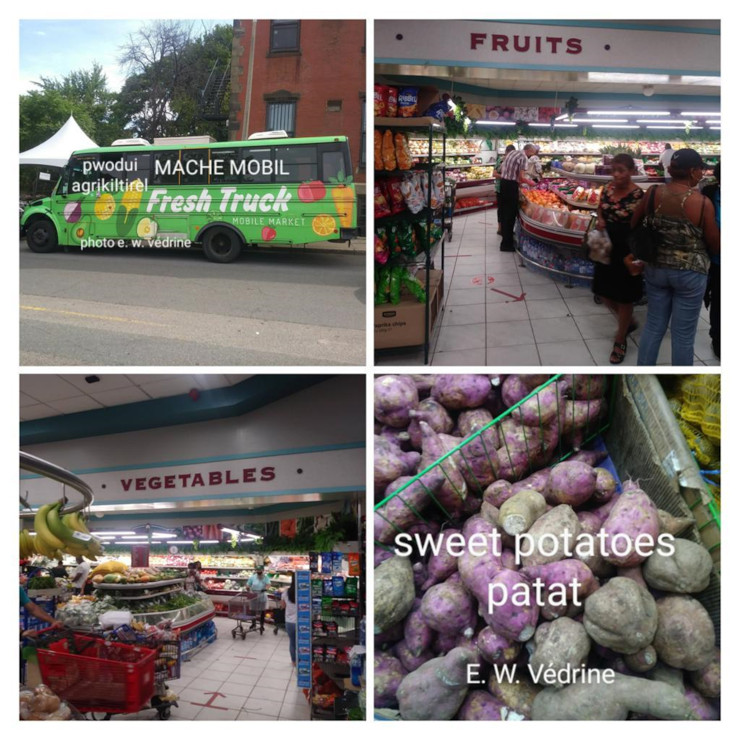
Photo: E. W. Vedrine Creole Project.
picture (9) foto
(•) Fruits and vegetables in a supermarket : Fri e vejetal (legim) nan yon sipèmache
| Is this a model that can help the entire Haiti? Other things, with these types of reservoirs (or tanks), if you don't want to have plastic reservoirs, you can make concrete cisterns. The concrete cistern can also be underground. So when the rainwater on the house’s roof flows in the gutters it goes directly into the cistern. Or you may also channel other water in the area (for example rainwater) and you can gather all to flow into a cistern you may have. | Èske se yon modèl ki kapab ede tout Ayiti? Lòt bagay ankò, avèk tip rezèvwa sa yo, si w pa vle fè rezèvwa an plastik, ou ka fè sitèn an beton. Sitèn an beton an kapab anba tè. Konsa lè dlo lapli soti sou do kay la koule nan goutyè, l ale dirèkteman nan sitèn lan. Oubyen tou, ou gen dwa kannale lòt dlo ki nan zòn lan (dlo lapli pa egzanp) epi ou ka rasanble tout pou vin tonbe nan sitèn ke w ka genyen. |
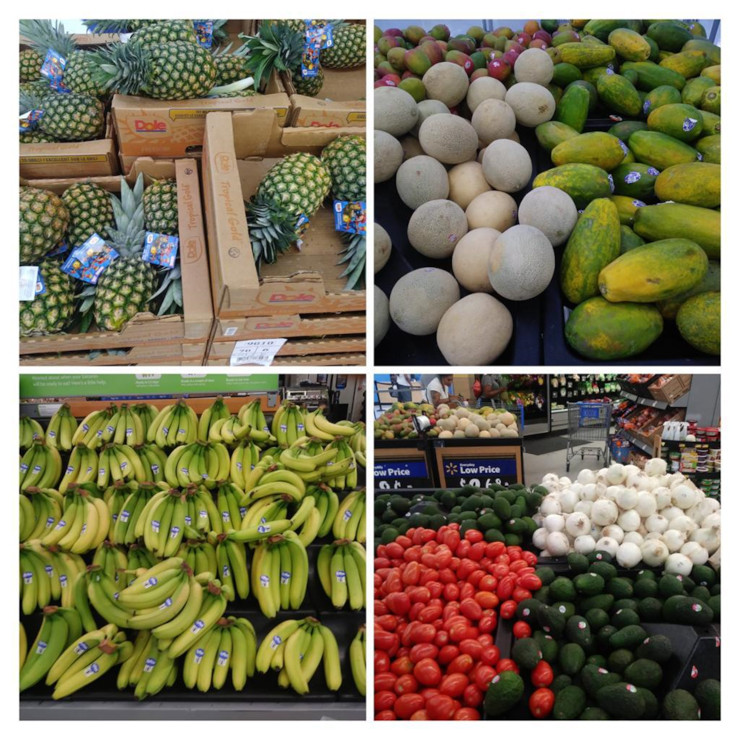
W. Vedrine Creole Project.
picture (10) foto
(•) Fruits and vegetables : Fri e vejetal (legim)
| Once connecting the hose conduit or having a water pump for example that can pump the water, you can adapt a pump to it. It’s something very important) to pump the water and distribute it to different hoses to irrigate gardens easily. These things can be done easily in Haiti to help ourselves, without spending too much money. | Depi w mete konduit kawotchou a oubyen gen yon ponp pa egzanp ki kapab ponpe dlo a, ou kapab adapte yon ponp ladan. Se yon bagay trè enpòtan pou ponpe dlo a, epi l voye nan kawotchou pou wouze jaden tèt fret. Se bagay fasil nou kapab fè Ayiti pou n ede tèt nou, san depanse anpil lajan. |

Photo: E. W. Vedrine Creole Project.
picture (11) foto
(•) Dam, water passage and wetlands
Rezèvwa, pasaj dlo e ma dlo (marekaj)
(•) Water dam for channeling and distributing water
to irrigate land and gardens
| You need food every day. Our big problem is that we produce very little food in Haiti. From that, we have a serious problem. If you can produce everything in agriculture, you can sell your products at the market. Now you have money, you can do different economic activities. For instance, (street) vendors or retailers can come and buy from you. So when you can produce in agriculture, it is something amazing. You can think about all you can do with agricultural products. | Ou bezwen manje chak jou. Gwo pwoblèm nou sèke nou pa pwodui anpil manje Ayiti. Apati de la, nou gen yon pwoblèm grav. Si w kapab pwodui tout bagay nan agrikilti, ou kapab vann sa w pwodui nan mache. Kounyeya ou gen lajan (kòb), ou ka fè diferan aktivite ekonomik. Pa egzanp, machann, revandè ka vin achte nan menm. Donk lè w ka pwodui nan agrikilti se yon bagay estraòdinè. Ou ka panse tout sa w ka fè ak pwodui agwo-alimantè. |
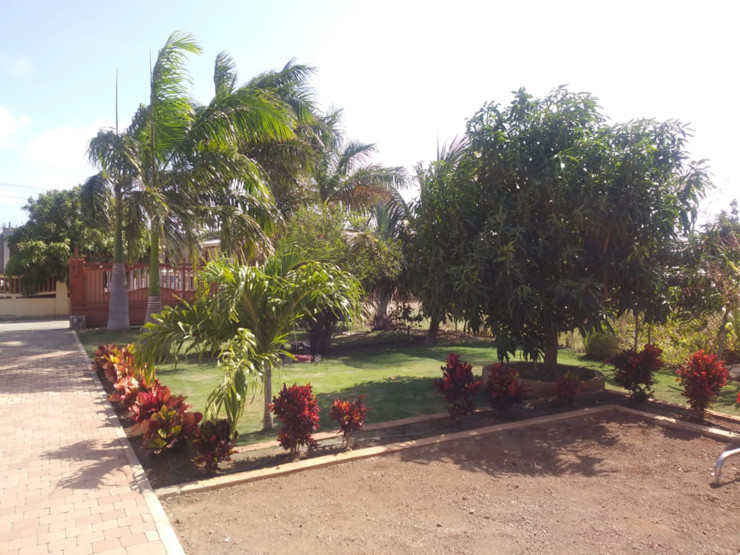
Photo: E. W. Vedrine Creole Project.
picture (12) foto
(•) Keep your courtyard beautiful and clean by planting trees in it.
Kite lakou w pwòp, epi plante pyebwa ladan l.
| Once you have your own land, you can think about all you can do with it. You can think of creating cisterns to make business, such as irrigating other people’s gardens for money. You can make deals with them to give you a percentage of their harvest (if they cannot pay you for irrigation in the beginning). All of these are projects that you can work on for example, especially teachers who don’t have anything to do in summer. | Yon fwa ou gen tè pa w, ou ka panse a tout sa w ka fè avè l. Ou ka panse kreye sitèn dlo pou fè biznis, tèlke awoze jaden lòt moun pou yo peye w. Ou ka fè dil ak yo pou ba ou yon pati nan rekòt la lè y ap rekòlte (si yo pa ta gen lajan pou peye w pou irigasyon o kòmansman). Tout sa se pwojè ou kapab travay sou yo pa egzanp, espesyalman anseyan ki pa gen anyen y ap fè pandan ete. |
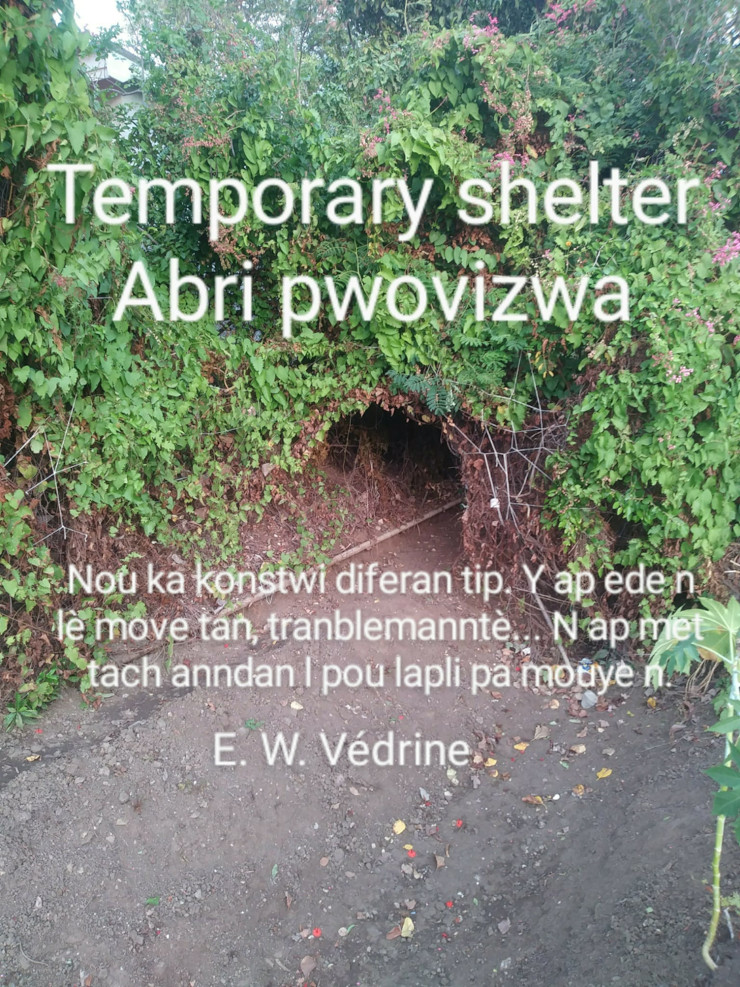
Photo: E. W. Vedrine Creole Project.
picture (13) foto
(•) We can build different types of temporary shelters to take a lunch break,
to take shelter from the sun /rain while working.
Nou ka konstwi diferan tip abri pwovizwa pou pare midi, solèy / lapli pandan n ap travay.
| Go to other communes. Go north, south, west, east. Visit other places. Make friends with people from other places. See what they are doing in their own commune as activities. Now, you have new ideas that can help you; apply them to your own commune. | Ale nan lòt komin. Ale nan nò, sid, west, lès. Vizite lòt kote. Fè zanmi ak moun ki soti lòt kote (nan lòt andwa). Gade kisa y ap fè nan komin kote yo soti a kòm aktivite. Kounyeya, ou vini avèk ide tounèf ki ka ede w, epi aplike yo nan pwòp komin ou. |
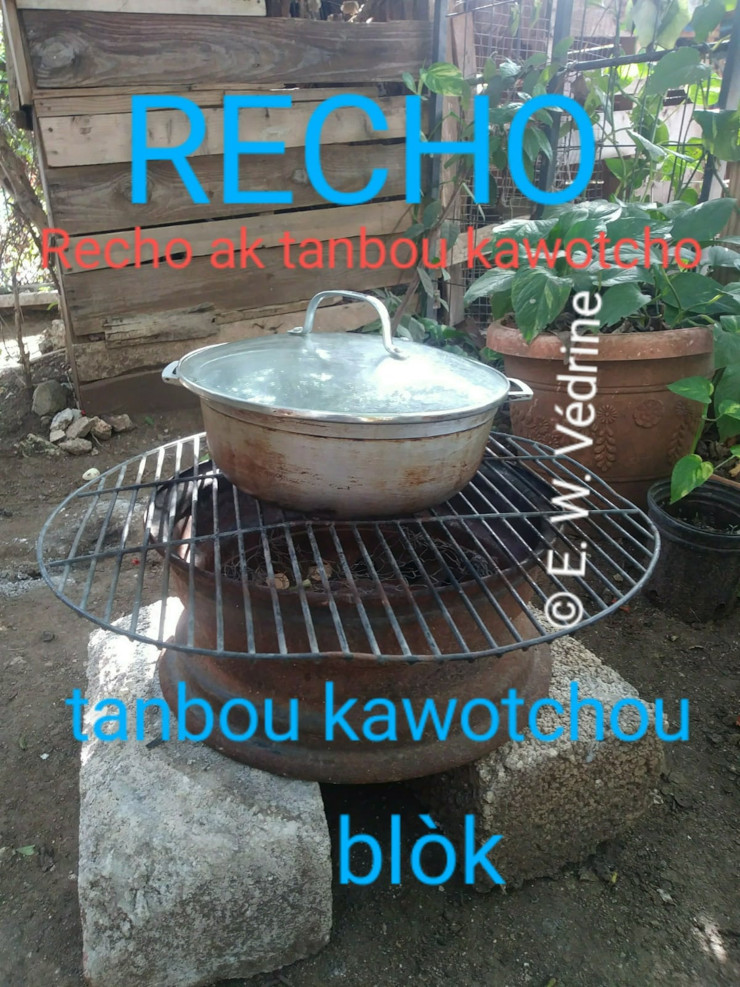
Photo: E. W. Vedrine Creole Project.
picture (14) foto
(•) Charcoal burner made of a tire’s drum and placed on two
blocks to cook food (while in the field).
Recho ki fèt ak tanbou kawotchou, epi plase sou de (2) blòk
pou kwit manje (pandan w nan jaden).
VOCABULARY : VOKABILÈ
agricultural products. pwodui agrikiltirèl
agriculture. agrikilti
animal. animal (bèt)
Arabian soil. tè fètil
avocado. zaboka
bamboo. banbou
banana. bannann; fig
block. Blòk
box. bwat
canal. kanal
cantaloup. kantaloup (melon Frans)
charcoal burner. recho
collective work (in the field). konbit (kòve)
countryside. pwovens; andeyò
dam. baraj
deforestation. debwazman
drought. sechrès
farmer. agrikiltè
food. manje
forest. fore
fruit. fri
garden. jaden
gutter. goutyè
hose. kawotchou
hunger. grangou
juice. ji
lemon. sitwon
mango. mango
market. mache
nursery. plantil, pepinyè
onion. zonyon
pan. chodyè
papaya. papay
peasant. peyizan
pinaple. anana
pomp. ponp
potato. pòmdetè
pound. liv
product. pwodui
rain. lapli
reforestation. rebwazman
reservoir; dam. rezèvwa
river. rivyè (larivyè)
scale. balans
shelter. abri
soil. tè
spring (water). sous (dlo)
squash. joumou
sweet potato. patat
tomato. tomat
tool. zouti
underground reservoir. rezèvwa souteren (anba tè)
vegetable. legim
water pomp. ponp dlo
water way. wout dlo
well. pui (pi)
VÈB : VERBS
to be hungry. grangou
to buy. achte
to channel (water). kannale dlo
to cook. kwit, kuizine (fè manje)
to cut. koupe. to ~ down trees: koupe bwa
to deforest, to cut down trees. debwaze
to deforest. debwaze
to destroy. detwi
to die out (plant). mouri (plant)
to dig. fouye
to display. espoze, mete avidèy
to drink. bwè
to eat. manje., 2. to graze (animal)
to grow. grandi (gwosi; devlope; pwofite)
to harvest. rekòlte (mwasone)
to irrigate. wouze (awoze)
to light up. limen
to live. viv
to need. bezwen
to pile up. anpile
to plant. plante
to produce. pwodui
to produce. pwodui
to rain. tonbe (lapli, fè lapli)
to reforest. rebwaze
to sell. vann
to wash. lave
to water. wouze (awoze)
to weight. peze
to work. travay
to yield. donnen
ANNEXED TEXTS : TÈKS ANEKSE
PALLI, Francesca. Arbres de la Martinique.
RENÉ, Jean Erich. Kijan yon plant fèt. (How a plants is made : Formation d'une plante).
---. Rasin yon plant (Roots of a plant : Les racines d’une plante).
VÉDRINE, Emmanuel W. Agriculture the first Target for Haiti's Development : Agrikilti ta dwe premye sib nan devlopman Ayiti.
---. Ann pale de bwa ak fri Ayiti!. (Let's talk about trees and fruits in Haiti! : Parlons de bois et fruits en Haïti).
---. Ayiti va bèl lè n va antere negativite yo : Haiti Will be beautiful when we bury the negativities.
---. Bilingual Education in Haiti: Theory and Practice | Edikasyon Bileng Ayiti: Teyori e Pratik.
---. Chanje mantalite pou ranvèse kondisyon povrete Ayiti : Changing mentality to curb poverty condition in Haiti.
---. Dyalòg sou rebwazman an Ayiti (Dialog on reforestation in Haiti”. (Dialogue sur le reboisement en Haïti).
---. Estrateji pou devlope wout Ayiti : Strategies to develop roads in Haiti.
---. Haiti and the destruction of nature : Ayiti, yon peyi ravaje nou dwe sispann detwi. (Haïti et la destruction de l'environnement).
---. INSMINOGEC (Institution Mixte de la Nouvelle Génération des Cayes) – Teaching Materials for Haitian Bilingual Programs in Haiti (courtesy E. W. Védrine Creole Project.
---. Kreyòl, de epòk kolonyal a 2022.
---. Quelques plantes créoles et leurs noms en latin. (Kèk plant kreyòl ak non yo an laten : Some Creole plants and their names in Latin).
---. Sezon sechrès Ayiti. (2nd. ed.). JEBCA Editions. 224 p. [English summary : Resumé en anglais]. [© The author’s copyright : © Dwa otè a] . [© Lexical data (for hyper base software for dictionaries) : © Done leksikal (pou lojisyèl ipèbaz pou diksyonè)]. [In Papiamentu language, Temporada di sekura na Haiti. [First original Creole version was published in 1994: Soup to Nuts Publishers, Cambridge, MA. 1994. 128 p. [The novel has been translated to English by the author (Emmanuel W. Védrine). [Text in pdf format : Tèks an fòma pdf]. VEDCREP: Boston (edition, 2013, 163 p. [“In Sezon sechrès Ayiti, the author presents a Haiti the way it exists through the eyes of characters. Sezon sechrès Ayiti is a historical novel written in the Haitian language and one that is written in a simple language, presented in a historical, political and economic context: what happened in Haiti, what happened recently, and what continues to happen. The philosophy and psychology of the people are about the same: they all would like to see a beautiful Haiti, one where everyone can work together. They are victims of the drought, of the crimes going on in the country and o abuses done to them. They are leaving Haiti for same causes though they like the country but the situation forces them to leave. Despite of all the crimes and abuses committed to them, they don't ask for anything wrong to happen to the criminals, but they would like them give up all that is evil, they would like them to change so that there can be a real change in the country” • NOTE: 10 chapters -- A textbook prepared for high school level, for native speakers who want to master writing in standard Haitian Creole (H.C), and for learners of H.C (intermediate & advance level) with questions on each chapter, and a Creole – English glossary • Kèk tèm nan Sezon sechrès Ayiti pou disètasyon : Some themes in (the novel) Sezon sechrès Ayiti for essays] • Kesyon sou dis (10) chapit yo : Questions on the ten (10 chapters.
---. Ten gifts for all Haitians : Dis kado pou tout Ayisyen.
---. Welcome to L’Asile (Lazil), a commune in Haiti: Byenveni nan Lazil, yon komin Ayiti.
---. What’s really needed to be done to reforest Haiti? : Kisa k dwe fèt reyèlman pou rebwaze Ayiti?)
: Le reboisement d’Haïti, un défi politique et environmental.
Note for research : Nòt pou rechèch
• Bilingual education (in Haitian Creole / Kreyol - French, Creole – English) : Edikasyon bileng (an kreyòl ayisyen – fransè – anglè) • Creole linguistics: Lengwistik kreyòl • Creole literacy projects : Pwojè alfabetizasyon kreyòl • Creole philology: Filoloji kreyòl • Database in Haitian Creole : Bank done an kreyòl ayisyen • Dictionaries on Haitian Creole : Diksyonè sou kreyòl ayisyen • Dictionary and glossary projects : Pwojè diksyonè e leksik • Documents for training sessions for Haitian lexicographers : Dokiman pou fè seyans fòmasyon pou leksikograf ayisyen • Educational materials in English and Haitian Creole for schools in Haiti : Materyèl edikatif an anglè e an kreyòl ayisyen pou lekòl Ayiti • Educational materials for Haitian teachers’s training : Materyèl edikatif pou fòmasyon anseyan ayisyen • Educational resources, training and orientation sessions for Haitian teachers : Resous edikatif, trening e seyans oryantasyon pou anseyan ayisyen • French based Creoles : Kreyòl a baz fransè • Haitian Creole lexicon : Leksik kreyòl ayisyen • Haiti, Linguistic planning (amenagement linguistique) : Ayiti, amenajman lengwistik • History of the Haitian Bilingual Programs (in Massachusetts /Boston, the United States : Istwa Pwogram Bileng Ayisyen nan Massachusetts /Boston, Etazini • Materials for Long distance tutoring for learners of Haitian Creole : Materyèl pou bay leson patikilye long distans pou moun k ap aprann kreyòl ayisyen • Orientating Haitian teachers : Oryante anseyan ayisyen • Research on Haitian Creole Lexicology: Rechèch sou leksikoloji kreyòl ayisyen • Seminars for Haitian Teachers on Teaching Materials : Seminè sou materyèl didaktik / pedagojik pou anseyan ayisyen • Stragies to develop Teaching Material Models in Haitian Creole (Kreyòl) : Estrateji pou devlope modèl materyèl didaktik / pedagojik an kreyòl ayisyen • Teaching Materials for Haitian Bilingual Programs : Materyèl didaktik /pedagojik pou Pwogram Bileng Ayisyen • Teaching Materials in Haitian Creole (Kreyòl) for learners of the language (beginning, intermediate and advance level) : Materyèl didaktik /pedagojik an kreyòl ayisyen pou moun k ap aprann lang nan (nivo entwodiksyon, entèmedyè e avanse).
* * *
Courtesy: Koutwazi
E. W. Védrine Creole Project, Inc. (1992)
Boston, Massachusetts. USA
*
